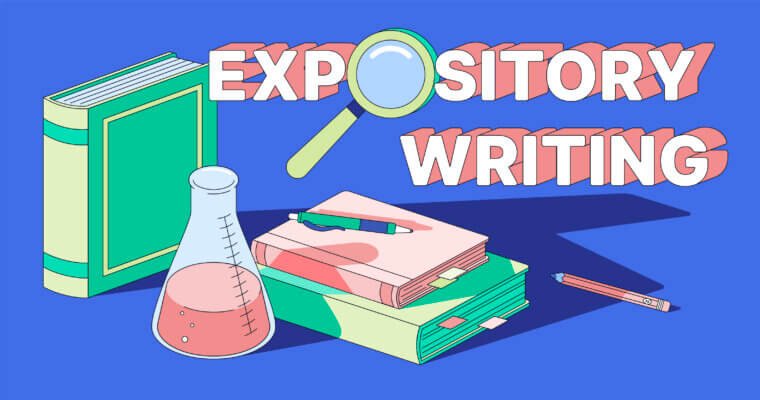
Expository writing, as its name implies, is writing that exposes facts. In other words, it’s writing that explains and educates its readers, rather than entertaining or attempting to persuade them. When you read a scholarly article, a textbook page, a news report, or an instructional guide, you’re reading expository writing.
What is expository writing?
Expository writing is writing that aims to inform its reader. As we mentioned above, this includes all types of factual writing, like textbooks, news stories, technical guides, and pieces of business writing. Many journalistic pieces are pieces of expository writing, but not all are—advertorials, opinion pieces, and many pieces of political writing are not pieces of expository writing because their primary goal is something other than providing unbiased facts.
An easy way to understand expository writing is to compare and contrast it with other types of writing. Three other commonly recognized types of writing are descriptive, narrative, and persuasive. Each of these types of writing has a specific goal. Descriptive writing creates a sense of time, place, and experience in the reader’s mind. Narrative writing tells the reader a story. Persuasive writing convinces the reader that a specific position is the right position. Expository writing gives the reader the facts they need about a specific topic to deepen their understanding of it.
Expository writing is:
- Factual
- Usually presented in a linear format
- Always presented in a logical format
- Objective
- Clear about its purpose
Expository writing is not:
- The author’s opinion
- An attempt to change the reader’s mind or shape their perspective
- Subjective
- Nonlinear or otherwise unconventional in how it presents content
Expository writing can still be fun and engaging
Although expository writing is fact-based, it doesn’t need to be dry or boring. Skilled writing can present factual information in an engaging way that only increases the reader’s comprehension of the topic, often by borrowing techniques used in narrative and descriptive writing to make the facts more vivid and impactful. If you’ve ever seen the docuseries Cosmos, you’ve seen engaging expository writing in action. In both the 1980 and 2014 versions, the host captivates viewers by guiding them through our known universe, our solar system, and how life on Earth evolved over millennia. Although Cosmos is a docuseries, the narrative that speaks directly to the viewer and constantly positions them within our universe’s story is a kind of expository writing: screenwriting.
However, discerning an expository piece’s credibility can be tricky at times. Remember one of the kinds of writing we mentioned above, advertorials? An advertorial is an advertisement disguised as an editorial. In other words, it’s an article presented as either fact or the author’s personal thoughts, but really, it’s a sponsored advertisement. Advertorials aren’t the only instance where you can find subjective opinions disguised as objective facts—many documentaries, journalistic pieces, books, and even scholarly articles are written according to the author’s bias or to fit a specific agenda.
This is why it’s so critical to carefully vet every source you use when you’re working on an expository writing assignment. Inadvertently using a biased source in your academic writing can undermine your work by making it look like you either didn’t research the topic carefully or are pushing a specific agenda in your writing.
Types of expository writing
There are numerous ways to present topics in a piece of expository writing:
- Compare and contrast. In a compare-and-contrast essay, you present two or more subjects and write about their similarities and differences.
- Definition. This type of expository writing defines a subject. For example, you might write a piece that defines a historic figure by exploring their actions, motivations, and circumstances.
- Classification. In a classification piece, you write about the characteristics of multiple subjects within one category. For example, you might write a blog post about the types of expository writing. In that blog post, you explain each type of expository writing, covering their differences as well as their similarities.
- Problem and solution. In a problem and solution piece, you explain an existing problem and then explore the most effective solution for that problem. This kind of structure can also be found in persuasive writing, but when it’s used in expository writing, it’s generally used in troubleshooting guides and to explain how specific problems have been solved.
- Process. When you need to explain how a process works or the steps the reader needs to follow to assemble something or complete another task, you write out the process step by step, providing as much explanation as necessary for each step.
Just like the other commonly recognized writing styles, you’ll find lots of drastically different expository writing examples. Technical manuals and research papers are both types of expository writing. So are lab reports, investigative journalism pieces, expository essays, and explainer video scripts. Even recipes count as pieces of expository writing, as do travel guides and biographies.
How to do expository writing effectively
As a student, many of your writing assignments are pieces of expository writing. Presenting facts in a logical, clear way is a much different task from writing a fictional story or supporting your opinion. Here are a few tips to keep in mind when you’re completing expository writing assignments:
Work through the entire writing process
The first step in writing a strong piece isn’t typing words on a screen, but rather brainstorming your topic. With other kinds of writing, like narrative or persuasive writing, you might have a clear idea of what you want to write from the moment you receive your assignment and, with it, skip ahead a few steps in the writing process. But because you’re working with facts and a strategy for presenting them in a coherent, engaging way, you’ll need to devote time to thoroughly brainstorming, researching, outlining, and then drafting your work.
Be creative, but constrained
There’s room to have a little fun in your expository writing, but it’s not going to be a party on the page. Use literary devices like similes and juxtaposition sparingly and only when they serve to make the facts clearer to your reader.
Always check the facts
Expository writing is all about the facts. When you’re researching, you might come across contradictory sources. If this happens, examine the conflicting information to find the truth. You can do this by researching that specific piece of information and finding what other scholarly sources have to say about it and by examining who published the two conflicting sources. If one is a personal blog and the other is an article from a .edu or .gov website, the latter is more likely to be unbiased.
Share the facts with style
Expository writing is logical and fact-based, but it doesn’t have to be boring. In fact, it shouldn’t be. But it’s not always easy to present facts and figures in an engaging style.
Grammarly can help. Our writing suggestions ensure you’re using engaging vocabulary and that your sentences flow clearly. In addition, with Grammarly’s tone detector, you can instantly see how your writing is communicating with its reader: confident, friendly, direct, and casual are just a few of the tones Grammarly can pick up.






